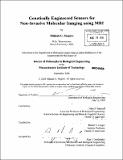| dc.contributor.advisor | Alan P. Jasanoff and Robert S. Langer. | en_US |
| dc.contributor.author | Shapiro, Mikhail G | en_US |
| dc.contributor.other | Massachusetts Institute of Technology. Dept. of Biological Engineering. | en_US |
| dc.date.accessioned | 2011-02-23T14:30:45Z | |
| dc.date.available | 2011-02-23T14:30:45Z | |
| dc.date.copyright | 2008 | en_US |
| dc.date.issued | 2008 | en_US |
| dc.identifier.uri | http://hdl.handle.net/1721.1/61215 | |
| dc.description | Thesis (Ph. D.)--Massachusetts Institute of Technology, Dept. of Biological Engineering, 2008. | en_US |
| dc.description | Cataloged from PDF version of thesis. | en_US |
| dc.description | Includes bibliographical references (p. 126-138). | en_US |
| dc.description.abstract | Technologies that provide information about the concentrations or activities of specific molecules in living subjects have the potential to greatly advance science and medicine. Magnetic resonance imaging (MRI) is a tool uniquely suited to this task because of its ability to image deep inside tissues at relatively high spatial and temporal resolution. However, the range of molecular phenomena currently accessible to MRI is limited by a lack of suitable molecular sensors. Most efforts to create such sensors have focused on synthetic contrast agents, whose complicated structures make them difficult to engineer, synthesize and deliver to target tissues. If MRI sensors could instead be made of proteins, a number of these difficulties could be mitigated. Here, we describe two platforms for the development of protein-based molecular sensors for MRI. The first is based on the heme domain of the bacterial cytochrome P450-BM3, which produces changes in TI contrast in MRI in response to small molecule binding. We developed a high-throughput assay that allowed us to evolve this protein into a sensor of the neurotransmitter dopamine (DA). We then used it to image DA release from cultured cells and cocaine-induced changes in DA transport in the brains of living rats. The second platform is based on the human iron storage protein ferritin (Ft), which enhances T2 contrast in MRI upon self-aggregation. We developed a system to express self-assembled Ft nanoparticles incorporating multiple surface functionalities, and used it to create a sensor for protein kinase A activity. Our results provide a proof of concept for two novel platforms for protein-based MRI sensor development, and highlight some key advantages of this approach over the synthetic methods used previously. | en_US |
| dc.description.statementofresponsibility | by Mikhail G. Shapiro. | en_US |
| dc.format.extent | 151 p. | en_US |
| dc.language.iso | eng | en_US |
| dc.publisher | Massachusetts Institute of Technology | en_US |
| dc.rights | MIT theses are protected by copyright. They may be viewed, downloaded, or printed from this source but further reproduction or distribution in any format is prohibited without written permission. | en_US |
| dc.rights.uri | http://dspace.mit.edu/handle/1721.1/7582 | en_US |
| dc.subject | Biological Engineering. | en_US |
| dc.title | Genetically engineered sensors for non-invasive molecular imaging using MRI | en_US |
| dc.type | Thesis | en_US |
| dc.description.degree | Ph.D. | en_US |
| dc.contributor.department | Massachusetts Institute of Technology. Department of Biological Engineering | |
| dc.identifier.oclc | 701334928 | en_US |
